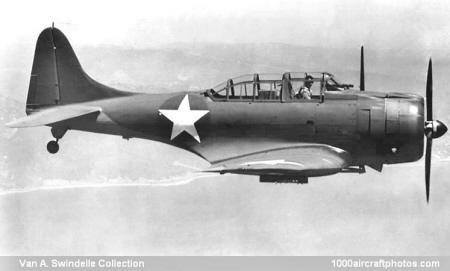07/31/2011. USAAC interest in the single-engined two-seat high-performance dive-bomber was aroused in 1940 by the successes then being enjoyed in Europe by the Luftwaffe's Junkers Ju 87 Stukas. Aircraft in this category were already in production for the USN. Designated A-24, the Douglas attack bomber was similar to the SBD, its USN forerunner, apart from the deletion of carrier-deck-operating features.
Powered by an 1,000 hp R-1820-52 engine, the A-24 could carry a 1,200 lb (544 kg) bomb load and was armed with two fixed forward-firing 0.50 in (12.7 mm) machine guns, and two 0.30 in (7.62 mm) machine guns in the rear cockpit. To meet what was considered at the time to be an urgent need, 168 A-24s were ordered (s/n 41-15746 to 41-15823) and were delivered from the USN production line at El Segundo between June and October 1941. These were USN aircraft, delivered with the designation SBD-3A (for Army) stenciled on the tail, the deck hook removed and a pneumatic tail wheel tire in place of the solid one.
In the light of the deteriorating situation in the Pacific in November 1941, 52 of these A-24s were dispatched by sea for the Philippines, to be used by the 27th Bombardment Group (L). When the Philippines were attacked, they were diverted to Australia where they arrived in Brisbane in December 1941. In February 1942 the 91st Bombardment Squadron took them to the Netherlands East Indies, where they were first used operationally; both here and subsequently in the hands of the 8th Bombardment Squadron (3rd B Group) in Australia they were found too slow, too short of range and too vulnerable for continued operation.
Nevertheless, further contracts were placed, for 170 A-24As (s/n 42-6772 to 42-6831, 42-60772 to 42-60881) in 1942 and 615 A-24Bs (s/n 42-54285 to
42-54899) in 1943. The A-24A, equivalent of the USN SBD-4, was built at El Segundo and had a 24-volt electric system. The A-24B (SBD-5 equivalent) had an 1,200 hp R-1820-60 and was built at Tulsa.
A few A-24s were retained in the USAF inventory until 1950, however, when the 'A' designation category was dropped in 1948, they were redesignated
F-24A and F-24B, and were used in trials connected with dive-bombing attacks by fighter-bombers. A single QF-24A (s/n 48-44) was a radio-controlled drone for special tests, controlled from the single DF-24B (s/n
48-45), these were additional SBDs acquired from the Navy in 1948.
